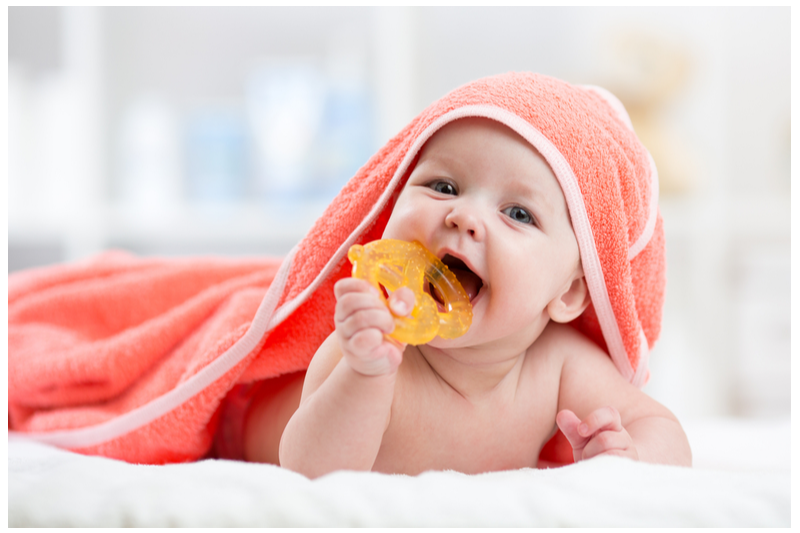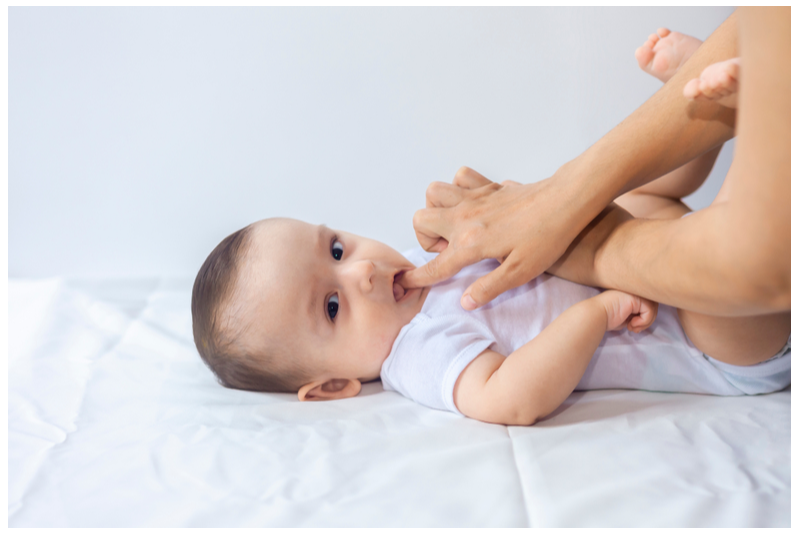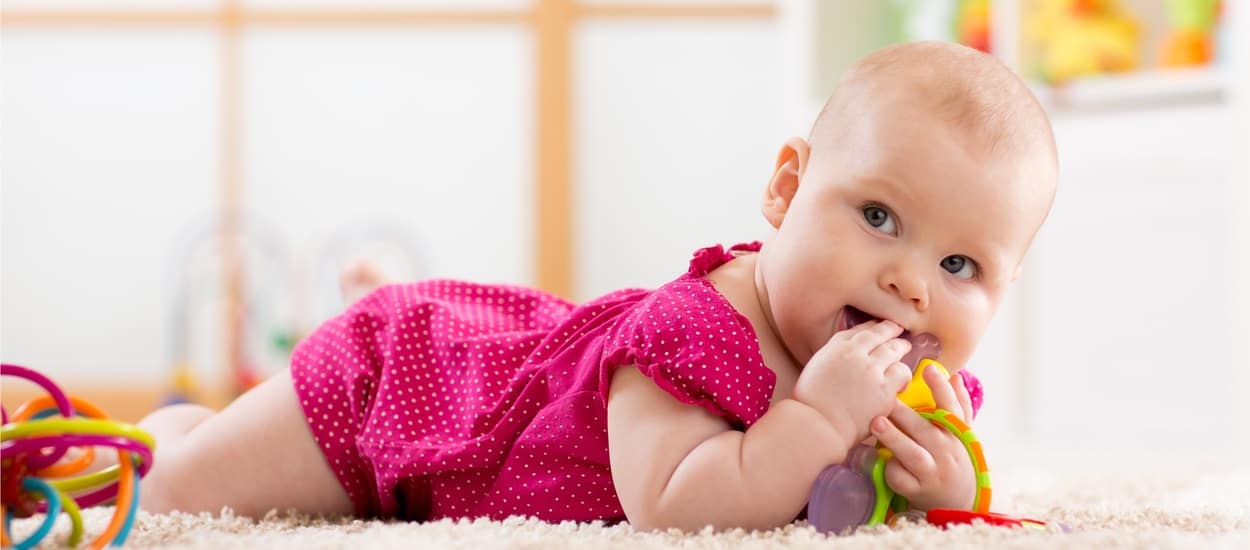Teething is the time when teeth begin to grow up and through the gums. It is also the word we use to talk about the feelings and behavior that come with growing teeth. Babies who are irritable and cannot sleep may be said to be teething when another cause for the behavior cannot be found.
Babies are born with teeth. These baby teeth, or primary teeth, lay beneath the baby’s gums. A baby may begin the process of teething as early as 3 months. The first tooth usually appears at around 6 months, but can come in at 3 months or as late as 12 months. Most children have all 20 baby teeth in place by the time they are 3 years old.
The bottom front teeth are usually the first teeth to come in. A month or two later, the top front teeth come in. Then the lateral incisors in the next spot over, come in. Next come the molars closest to the opening of the baby’s mouth. Then come the canine teeth on either side of the lateral incisors, and finally, the second set of molars in the back of the baby’s mouth.
Teething pain may begin 2-3 months before a tooth appears. Pain from teething will usually be at its worst in the 3-5 days before the tooth comes through. The pain usually goes as soon as the tooth breaks through the gums. Some lucky babies don’t seem to be bothered by teething at all.
Teething babies may chew on anything in reach in an effort to counter the painful pressure on their gums. At the same time, babies may not want to eat or drink when teething, since their mouths are hurting.
Signs of Teething
It’s normal for your baby to be cranky and unhappy while teething. Your baby may be teething if he or she is:
- Fussy
- Wakeful
- Irritable
- Doesn’t want to eat
- Drooling more than is usual
- Rash or chapping on chin, from drooling
- Gagging or coughing with no sign of cold, flu, or allergies
- Pulling on ears or rubbing at cheeks
Some crankiness and other teething symptoms are normal. But it’s time to call the doctor if your baby is teething and has:
- Fever
- Rash on body
- Diarrhea
Pain Soothers
A baby’s gums may be sore and painful as the teeth begin to erupt. You can try rubbing the baby’s gums gently but firmly with a clean finger for two minutes at a time. Some babies like to chew on a teething ring. Make sure to keep the teething ring clean. It can help to refrigerate the teething ring. Something cold soothes the pain of teething.
Just as a cold teething ring feels good, so do cold foods. If the baby is old enough to eat, try offering some cold applesauce, yogurt, or pudding. A cold drink is good, too. But don’t give the baby ice or anything frozen as this can pose a choking hazard. Ice cream or sorbet are fine if the baby likes them.

Are Numbing Gels for Teething, Safe?
The Food and Drug Administration recommends against using products with benzocaine for babies under the age of 2, unless a doctor rules otherwise. The active ingredient found in most over-the-counter teething remedies, for instance, Baby Orajel, is Benzocaine. Benzocaine has been linked to a rare but dangerous and even sometimes fatal medical condition called methemglobinemia, in which too little oxygen reaches the blood stream.
The FDA also asks that parents not use homeopathic teething tablets which can contain a toxic ingredient called belladonna. If you have homeopathic teething tablets in your home, the FDA suggests you throw them away. If you have used homeopathic tablets accidentally, call your child’s doctor for advice.
It’s okay to give your baby an over-the counter pain reliever for babies when teething pain is bad. Use with care as directed on the label. Never give a baby aspirin, since aspirin in those under the age of 20 may cause Reye syndrome, a rare but serious disease.

Teething Rash
The extra drooling caused by teething can irritate the skin around the baby’s mouth and chin. Try applying a layer of petroleum jelly to create a barrier against moisture on the baby’s tender skin.

Teething and Breastfeeding
A baby can find it irritating to suck during feedings and may not want to nurse. Offer a cup if the baby is 6 months or older. The baby may also bite you while nursing, not realizing this hurts you. When this happens, put your finger in the baby’s mouth to break the suction and say, “No, no,” very firmly. If the baby bites you a second time, end the feeding. Most babies will learn not to bite mommy quite quickly.

Dental Care
Good dental care will make sure your baby has healthy teeth and gums for life. Dentists recommend that dental care begin before the baby’s first tooth comes in. Each day, wipe your baby’s gums with a clean, damp washcloth or square of gauze. You can use a soft, baby-sized toothbrush with a bit of water if you like. Just don’t use toothpaste.
Caring for your baby’s mouth and teeth will keep the baby from developing tooth decay. Cavities can cause the baby to lose the primary teeth faster than normal. This means there will be gaps between the teeth, which can cause the permanent teeth to come in crooked or crowded.
Once the first tooth comes in, you can brush it with a very small amount of toothpaste. Use a toothpaste containing fluoride. Once the baby is old enough to spit, say at age 3 years, you can use a pea-sized amount of toothpaste. Keep the toothpaste out of reach and discourage your child from swallowing when brushing the teeth since toothpaste is toxic in larger amounts.
When the baby has all his or her baby teeth, brush them twice a day. The American Dental Association (ADA) recommends that babies be seen by a dentist by the age of 1 year or within 6 months after the first tooth comes in. This is a good time to ask the dentist any questions you may have about dental care or your child’s teeth.
